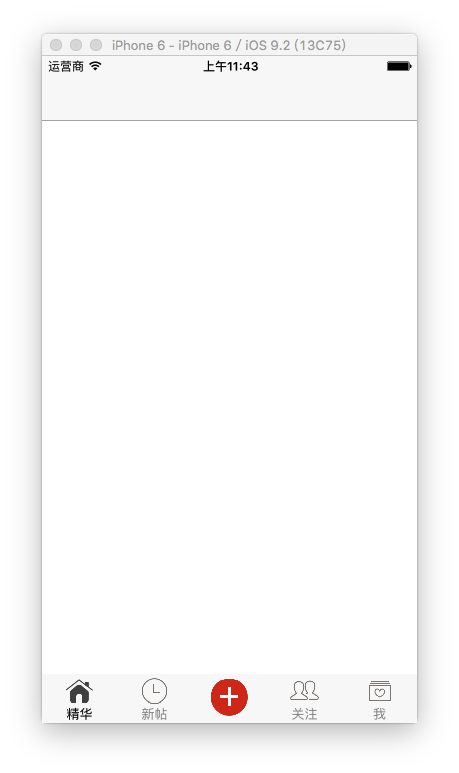第九篇、自定义底部UITabBar
国际惯例先上图:

代码实现(在UITabBarViewController设置):
- (void)setUpTabBar { LHLTabBar *tabBar = [[LHLTabBar alloc] init]; // 利用KVC对系统的tabBar进行赋值: KVC的原理是通过访问属性进行赋值,不是通过setter方法进行赋值 [self setValue:tabBar forKeyPath:@"tabBar"]; }
底部UITabBar
#import <UIKit/UIKit.h> @interface LHLTabBar : UITabBar @end
#import "LHLTabBar.h" @interface LHLTabBar () @property (nonatomic, weak) UIButton *plusButton; @end @implementation LHLTabBar - (UIButton *)plusButton{ if (_plusButton == nil) { UIButton *plusButton = [UIButton buttonWithType:UIButtonTypeCustom]; [plusButton setBackgroundImage:[UIImage imageNamed:@"tabBar_publish_icon"] forState:UIControlStateNormal]; [plusButton setBackgroundImage:[UIImage imageNamed:@"tabBar_publish_click_icon"] forState:UIControlStateHighlighted]; [plusButton sizeToFit]; [self addSubview:plusButton]; _plusButton = plusButton; } return _plusButton; } - (void)layoutSubviews { [super layoutSubviews]; // 布局子控件 NSInteger count = self.items.count + 1; CGFloat btnW = self.lhl_width / count; CGFloat btnH = self.lhl_height; NSInteger i = 0; for (UIButton *tabBarButton in self.subviews) { // 取出UITabBarButton if ([tabBarButton isKindOfClass:NSClassFromString(@"UITabBarButton")]) { if (i == 2) { i += 1; } tabBarButton.frame = CGRectMake(btnW * i, 0, btnW, btnH); i++; } // 隐藏tabBar黑线 NSString *subFrames = NSStringFromCGRect(tabBarButton.frame); NSString *blackLine = @"{{0, -0.5}, {375, 0.5}}"; if ([subFrames isEqualToString:blackLine]) { tabBarButton.hidden = YES; } } // plusButton self.plusButton.center = CGPointMake(self.lhl_width * 0.5, self.frame.size.height * 0.5); } @end


